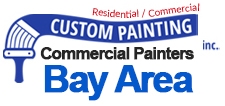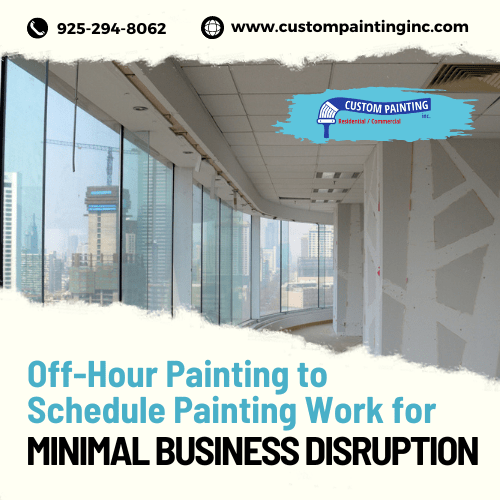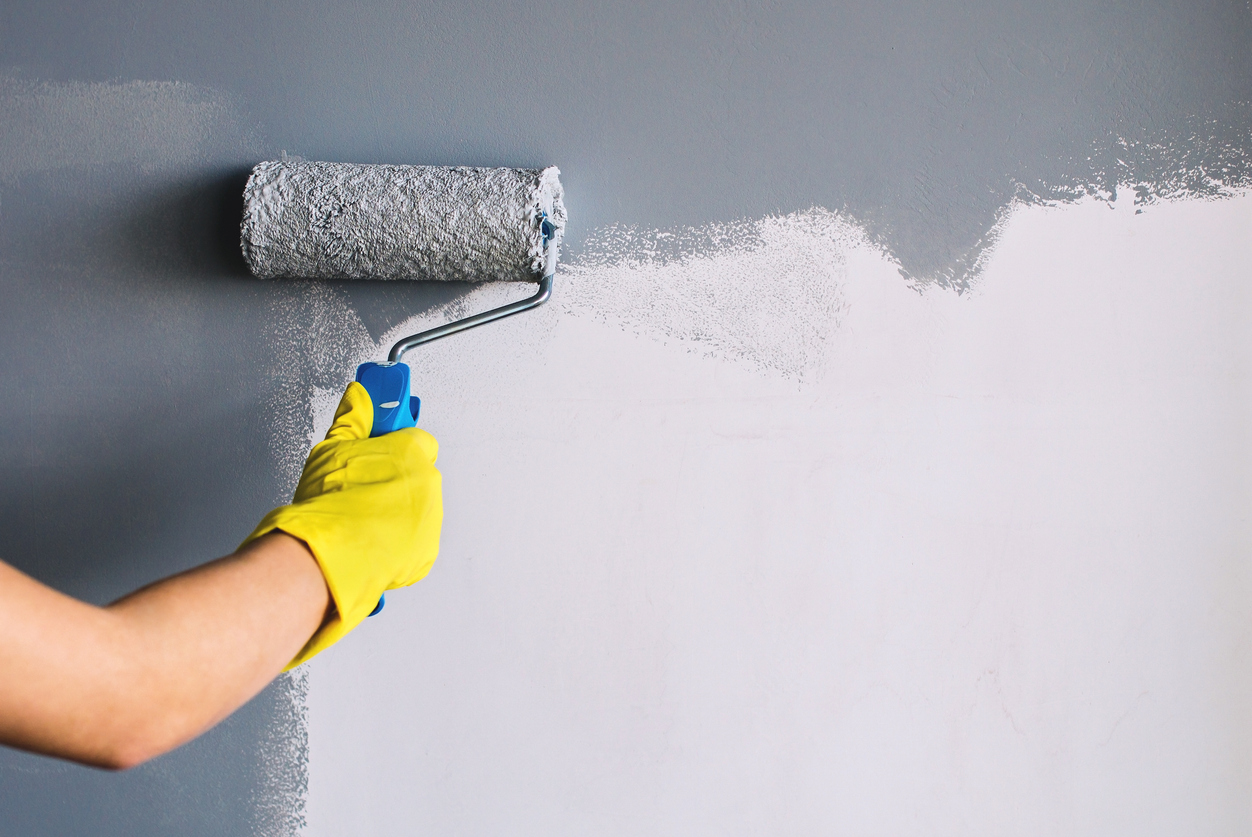If you have a business, it’s important to make a great impression on clients by keeping your building looking sharp. But let’s be honest—trying to get painting done during regular business hours can be difficult. It disrupts your workflow, bothers your staff, and might even turn away customers.
That’s where off-hour painting comes to the rescue. You can keep everything running smoothly without interruptions by scheduling painting work for evenings, weekends, or other times when your business is closed. In this post, we’ll dive into why off-hour painting is a game-changer, how it helps minimize disruptions, and some tips for making it work for your business.
Benefits of Off-Hour Painting
Off-hour painting offers several key advantages that can make a big difference for your business. Let’s break them down:
It minimizes business disruption.
One of the most significant benefits of off-hour painting is that it allows you to maintain regular operations without interruptions. Since the painting is done when your business is closed, your staff can carry on with their tasks as usual, and your customers won’t be inconvenienced. This seamless approach ensures that your business remains productive and professional throughout the painting process.
It enhances productivity.
Another major advantage is the boost in productivity. When painting is scheduled outside of regular business hours, your workflow remains uninterrupted. Employees can stay focused on their work without the distractions of noise, fumes, or sectioned-off areas, leading to a more efficient and harmonious work environment.
It allows for faster completion times.
Off-hour painting can also lead to faster project completion. With unhindered access to the entire space, painters can work more efficiently without having to work around people or equipment. This efficient use of time and resources means the job gets done quicker, allowing you to enjoy the fresh, new look of your business premises sooner.
Tips for Off-Hour Painting to Minimize Business Disruption
Here are some helpful tips so you can schedule your painting job during off hours and lessen disruption in your daily operations:
Choose an ideal time.
Pick a painting time that aligns with your business’s least busy hours. Weekends, evenings, or holidays are great choices to minimize disruption during your regular working hours. Also, consider your industry’s specific busy seasons or slower periods and plan painting during those lulls.
Then, schedule the painting during your off hours. By doing the work when your business is closed, you can ensure there are no interruptions to your daily operations.
Break the project into smaller chunks.
To further minimize disruptions, consider breaking the project into smaller, manageable chunks. This approach makes it easier on everyone and avoids the need to halt operations unless absolutely necessary. While large projects can be disruptive, smaller tasks can be scheduled during off-hours or times with lower traffic. Some parts of the project may need to be done all at once, but taking your time can help keep disruptions to a minimum.
Work with an experienced team.
The experience level of your painting team matters. Experienced commercial painters are less likely to cause disruptions because they have a set of best practices to follow. They know how to plan the project to minimize impacts and ensure that the painting project will be smooth.
Minimize customizations.
The more customizations you want, the more likely you are to experience disruptions. Custom painting projects take more time, require more tools, and often involve more people. Keeping the project simple makes it easier for the painters to get in and out quickly. If time, budget, or disruptions are a concern, always opt for simplicity.
Communicate clearly with employees.
It’s important to have clear communication with your employees. Let them know about the painting schedule, which areas will be painted, and any changes to their workspace. This way, they can plan accordingly and adapt to the temporary changes. Encourage them to share any concerns or suggestions to make the process smoother for everyone. If there’s a conflict in the schedule, go back and adjust the timing as needed.
Implement a phased approach.
For larger commercial spaces, consider a phased approach to painting. This allows the rest of the workspace to continue functioning normally while the painters focus on one area at a time. Breaking the project into manageable stages lessens the disruption to your business operations.
Clearly define the phases and their timelines to ensure a smooth transition from one phase to the next. Communicate these to employees so they can also plan ahead in case the transition affects their daily workflow and avoid accidental disturbances.
Use low-VOC paints.
Choose low-VOC (Volatile Organic Compounds) paints that emit fewer fumes and odors. This helps reduce distractions from strong paint smells, benefits the environment, and is better for your and your employees’ health.
Prepare items thoroughly.
Make sure to thoroughly prepare the area before painting begins. Cover furniture, flooring, and equipment to protect them from paint splatters. A well-prepared environment prevents unnecessary disturbances and damage. Clearly communicate the pre-painting preparation steps to everyone so they know what precautions to take.
Plan for drying time.
Allow enough drying time for the paint to set before resuming regular activities in the painted areas. Rushing this process can lead to streaks and additional work, causing more disruption. Coordinate with the painters to determine the necessary drying time and plan business activities accordingly. It’s also wise to have a backup plan for drying time.
Use fast-drying paints.
If possible, opt for fast-drying paint products to speed up the process and reduce downtime. This ensures that the area is ready for use sooner. Work with your painting team to select fast-drying paint options that fit your project timeline and minimize disruptions.
Maintain communication.
Keep everyone in the loop about the progress of the painting project. Regular updates to employees and customers reduce uncertainty and build trust and cooperation. Address any concerns or feedback quickly to show that you’re responsive and committed to customer satisfaction, which helps maintain positive relationships and minimizes business disruptions.
Open communication with the painting contractor is also crucial. It promotes collaboration and ensures everyone is on the same page, making the painting project smoother and less disruptive to your operations.
Plan for cleanup.
Planning for cleanup is just as important as the painting itself. Schedule regular cleanups to prevent debris from piling up and to keep the work environment safe for both employees and the painting team. Make sure to dispose of paint waste responsibly to minimize environmental impact and comply with regulations.
After the painting is complete, conduct a thorough cleanup to return your premises to a clean and orderly state. This will ensure that your business can resume normal operations without any disruptions.
Stay cool and manage.
Lastly, stay flexible and ready to adapt to any unforeseen circumstances. A fast approach can help minimize disruptions as you respond to unexpected challenges during the painting process. Stay professional under pressure and be prepared to make quick adjustments to the plan while minimizing disruptions.
How to Ensure Quality and Safety During Off-Hour Painting
When scheduling painting during off-hours, it’s essential to prioritize both quality and safety. Here are some key points to consider:
Provide proper lighting and ventilation.
Make sure the painting area is well-lit and adequately ventilated. Since off-hour painting usually happens at night or very early in the morning before the employees go to work, it’s essential to provide enough lighting to help painters see their work clearly and ensure a high-quality finish. Meanwhile, proper ventilation is crucial to prevent the buildup of paint fumes and keep the environment safe for everyone.
Comply with safety regulations.
Always adhere to safety regulations. This includes providing the necessary safety equipment and following guidelines to prevent accidents, protecting both your employees and the painting team.
Do quality control.
Implement strict quality control measures to get a professional-looking paint job. Use top-quality paints and materials to ensure surfaces are properly prepared before painting, and follow best practices throughout the process.
Regularly check progress.
Conduct regular progress checks to ensure the work is meeting your standards. Inspect frequently to catch any issues early so the contractor can correct them on time and to ensure the final result is up to par.
Conclusion
Through off-hour painting, you can get a professional paint job done at your premises without compromising your business’s daily activities. Consider this for your next project to keep your business looking its best while still operating seamlessly. As you probably know, maintaining a well-painted business environment is important since first impressions matter, especially to customers and clients.
If you want to refresh the look of your building but don’t want a big disruption to your daily operations, contact Custom Painting, Inc. today to schedule your project. Or, call us at 510-795-0903 to discuss your painting project. With us, you don’t have to sacrifice days or weeks of disruption to get a fresh coat of paint.



